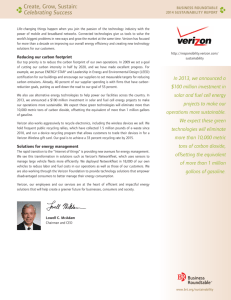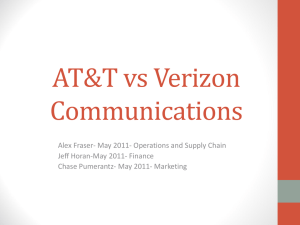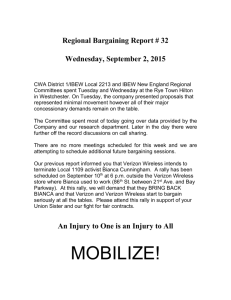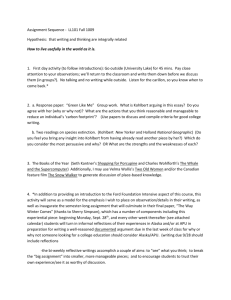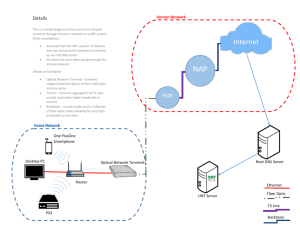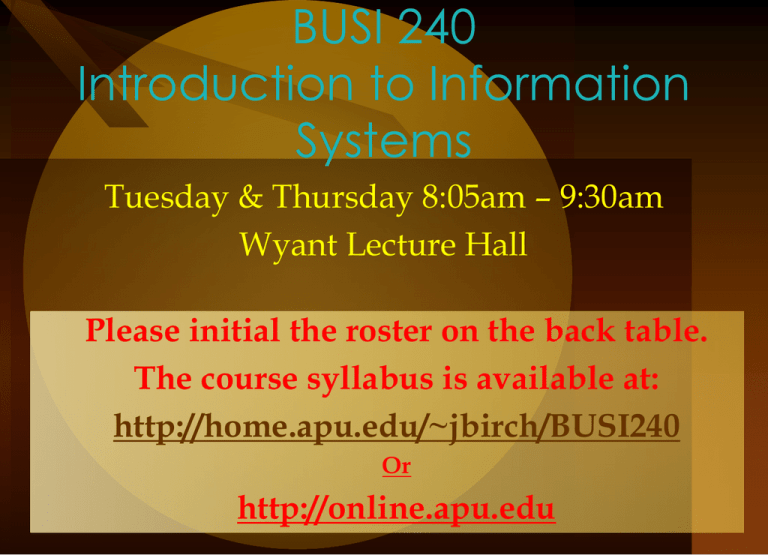
BUSI 240
Introduction to Information
Systems
Tuesday & Thursday 8:05am – 9:30am
Wyant Lecture Hall
Please initial the roster on the back table.
The course syllabus is available at:
http://home.apu.edu/~jbirch/BUSI240
Or
http://online.apu.edu
Current Events – What’s going on?
Apple, With or Without Steve Jobs
The maker of iPads, iPhones, and Mac computers will prosper
even if CEO Steve Jobs doesn't return. Keeping the company's
revolutionary edge will be harder
2-2
Current Events – What’s going on?
Meet Apple's New Boss, The Most Powerful Gay
Man in Silicon Valley
It looks increasingly like Steve Jobs' reign at Apple is over. If the
CEO doesn't return from his third, indefinite medical leave, COO
Tim Cook will succeed him, marking a new era not only for Apple
but for gay progress. Cook made his mark early on by fixing
Apple's notorious manufacturing inefficiencies:
2-3
Current Events – What’s going on?
Verizon Looks Beyond Mobile to 4G
With the U.S. mobile market well-saturated, Verizon is
campaigning to get 4G into products, including video
cameras and other consumer electronics, not usually
associated with digital high-speed networks
http://www.businessweek.com/magazine/content/10_39/b4196041876907.htm
2-4
Current Events – What’s going on?
Verizon Looks Beyond Mobile to 4G (cont’d)
Verizon's ultrafast fourth-generation network uses a technology
standard called Long Term Evolution, or LTE. Tim Horan, a
telecom analyst at Oppenheimer, estimates Verizon is spending
about $3 billion to upgrade its network to 4G service, which will
launch later this year. While current third-generation networks
allow for average download rates of up to 1.7 megabits per
second, 4G customers can expect to see average download
speeds of about 10 Mbps—fast enough to download a song in
about four seconds. That's faster than many home broadband
connections and zippy enough to stream live television to mobile
devices.
2-5
Current Events – What’s Going On?
Verizon Looks Beyond Mobile to 4G (cont’d)
Verizon is now replacing its Innovation Center with a bigger,
20,000-square-foot facility. The new center will house mockups of
hospital rooms, kitchens, and garages to showcase LTE-ready
products in realistic environments. The company hopes the
Innovation Center and a $1.3 billion venture capital fund it is using
to invest in some smaller companies will yield a large, growing
customer base for its 4G service.
2-6
Current Events – What’s going on?
4 Generations of Cellular Standards
http://cellphones.org/4-generations-of-cellular-standards/
2-7
Current Events – What’s going on?
Squeezing More Green Out of Brown
UPS managers are efficiency freaks. The company, for example,
tells drivers to avoid left turns because they take longer than
rights. Starting a few years ago it began rigging trucks with
sensors that give readings on everything from vehicle location to
brake pad wear. UPS says the system has reduced fuel use by 25
gallons per truck over the course of a year and allowed it to
replace parts before they break. Nearly half its 55,000-vehicle U.S.
fleet will be outfitted with telematics by yearend, yielding millions
of dollars in savings. ——Mary Jane Credeur
2-8
Current Events – What’s going on?
Special Delivery:
Where the Truck
Sensors Are
1. Headlights: Checks if
bulbs are working. 2.
Engine: Provides
readings on oil levels
and fuel use and
monitors how hard the
engine is working.
3. Brakes: Measures
how often and hard the
breaks are applied. 4.
Seat belt: Checks if it’s
buckled. 5.
Transmission: Measures
fluid levels and gear
changes.6. Data reader:
Collects over 200
streams of
information,uploaded
daily to UPS computers.
2-9
Cost-Saving Tips
Drivers are told
to carry the
ignition key on
the pinkie finger
of their nondominant hand
so they don’t
lose time
rummaging
through their
pockets.
1.
2.
3.
4.
5.
6.
Assignment #1
2-10
Spreadsheet is found in the Doc Sharing area of
http://online.apu.edu
Download the Assignment_1.doc file to your computer
Instructions for completing the assignment are in the
document
You will prepare a Microsoft Excel budget spreadsheet based
on the instructions.
Due February 3, 2011 – before 8:05am
Please submit assignments in Excel 2003 format (if you have
Office 2007, please “Save As”, and select 2003). All
Assignments should be submitted electronically to “Dropbox”
found at http://online.apu.edu before 8:05am February 3rd
Assignment #1
Assignments received after 8:05am will receive a
10% deduction. A 10% deduction will be levied for
each day the assignment is late.
However, points are points. If you miss the
deadline, turn in the assignment anyway.
Assignments can be reviewed up to 24 hours
before the assignment is due (before February 2nd
8:00am). Please email me and I will review and
return with recommendations.
2-11
Quiz #1
Covers
Chapters 1 & 2 from text book
20 questions, one (1) point per question
Quizzes are NOT group projects. They should be
taken individually.
Quiz will be taken online from http://online.apu.edu
Available: January 25, 2010 –at 9:30 am.
Due: January 27, 2010 – Tuesday – at 8:00 am.
2-12
Chapter
2b
Competing with Information
Technology
How can a business use IT to compete?
Competitive strategies and forces
McGraw-Hill/Irwin
Copyright © 2007 by The McGraw-Hill Companies, Inc. All rights reserved.
Customer-focused business
What
is the business value in being customerfocused?
Keep
customers loyal
Anticipate their future needs
Respond to customer concerns
Provide top-quality customer service
Focus
on customer value
Quality
value
2-14
not price has become primary determinant of
How can we provide customer
value?
Track
individual preferences
Keep up with market trends
Supply products, services and information anytime,
anywhere
Provide customer services tailored to individual
needs
Use Customer Relationship Management (CRM)
systems to focus on customer
2-15
Building customer value using the
Internet
2-16
Value Chain
View
the firm as a chain of basic activities that add
value to its products and services
Activities are either
Primary
processes directly related to manufacturing or
delivering products
Support processes help support the day-to-day running
of the firm and indirectly contribute to products or
services
Use
the value chain to highlight where competitive
strategies can best be applied to add the most value
2-17
Using IS in the value chain
2-18
Business Process Reengineering
Called
BPR or Reengineering
Fundamental rethinking
and radical redesign
Of
business processes
To achieve improvements in cost, quality, speed and
service
Potential
payback high
Risk of failure is also high
2-19
How BPR differs from business
improvement
2-20
A cross-functional process
2-21
Reengineering order management
2-22
Agility
Agility
is the ability of a company to prosper
In
a rapidly changing, continually fragmenting
Global market for high-quality, high-performance,
customer-configured products and services
An
agile company can make a profit with
Broad
product ranges
Short model lifetimes
Mass customization
2-23
Individual products in large volumes
Four strategies for agility
An agile company:
Provides products as solutions to their customers’
individual problems
Cooperates with customers, suppliers and
competitors to bring products to market as quickly
and cost-effectively as possible
Organizes so that it thrives on change and
uncertainty
Leverages the impact of its people and the
knowledge they possess
2-24
How IT helps a company be agile
2-25
Virtual Company
A
virtual company uses IT to link
People,
Organizations,
Assets,
And
ideas
Creates
to
interenterprise information systems
link customers, suppliers, subcontractors and
competitors
2-26
A virtual company
2-27
Strategies of virtual companies
2-28
Knowledge Creation
Knowledge-creating
organization
Consistently creates
company or learning
new business knowledge
Disseminates it throughout the company
And builds in the new knowledge into its products and
services
2-29
Two kinds of knowledge
Explicit
knowledge
Data,
documents and things written down or stored on
computers
Tacit
knowledge
The
“how-to” knowledge which reside in workers’
minds
A
knowledge-creating company makes such tacit
knowledge available to others
2-30
Knowledge issues
What
is the problem with organizational knowledge
being tacit?
Why are incentives to share this knowledge needed?
2-31
Knowledge management
techniques
Source: Adapted from Marc Rosenberg, e-Learning: Strategies for Delivering Knowledge in the Digital Age
(New York: McGraw-Hill, 2001), p.70.
2-32
Knowledge management systems
(KMS)
KMS
manage organizational learning and business
know-how
Goal:
Help
knowledge workers to create, organize, and make
available knowledge
Whenever and wherever it’s needed in an organization
2-33

